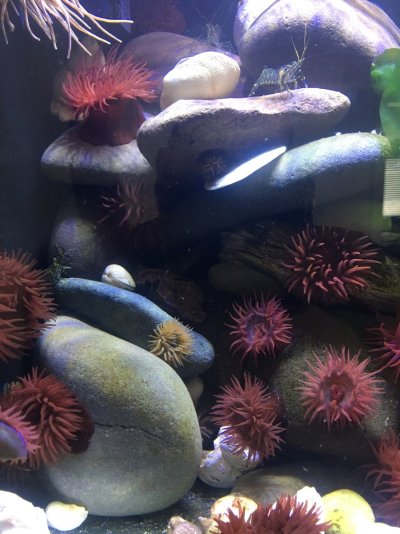Good evening everyone, i have been in the saltwater aquarium hobby for almost 6 years now and during this 6 years i have successfully kept many of the animals you encounter such as clownfish, tangs, anthias, shrimp, coral, anemones, you name it. As a california resident, i often take advantage of the breathtaking experience of the local tidepools particularly in the San Pedro. If youve been to the tidepools along the west coast, then youve probably seen the many fish and inverts that inhabit this beautiful delicate ecosystem. Among these animals are Opaleye (Girella nigricans), olive colored fish with gorgeous ocean blue eyes and the tidepool sculpin (Oligocottus maculosus). Let me get to the point, nobody plans on keeping these as pets as opaleye are often eaten and not really sought after on top of the fact they are wild and can introduce disease. People, my parents for one, often say "leave them in the ocean". I can say however as a hobbyist I have successfully kept these underappreciated yet majestic fish successfully with my other tank inhabitants.
How did I do it? Obviously you have to catch an opaleye, preferrably one less than 6 inches in length. The smaller, the easier to catch. You can catch very small ones about 3/4 of an inch easily with a net around summer, as they arent fast swimmers whatsoever. They can be kept in a 10 gallon at this stage and generally grow slowly. Have a bucket of seawater and keep them in it as youll need it during the acclimation process. You will keep them in a quarantine tank for at least 2 weeks like any other fish and dose 1 drop of copper per gallon, no more, no less. These fish arent used to such substances and dosing innapropriatley can prove to be fatal. They do wonderfully in both frigid and tropical waters. No heater required if you dont have one. After the quarantine period, you can safely introduce them to your reef tank, assuming you have no predatory fish tank. Opaleye get along beautifully with clownfish (be cautious with maroons), tangs and other peaceful/semi-aggressive fish. With my experience, they are reef safe with caution as they have the tendency to be nippy to softies like coral beauties but wont bully other tank mates unless they breed. Keep ph at 8.3 as always and have at least a 75 gallon to accomodate them when fully grown and have lots of liverock to hide in as these fish will be severely stressed if not. Highly reccomended to keep 2 or more as these are social fish. The results is very rewarding as these fish are highly intelligent and will eat from your hand, going as far as doing a small hop from the water and glass surfing upon entering the room. Truly magnificent.
Tidepool sculpins on the other hand are a completely different story. Long story short, they are extremely difficult to keep alive and are extremely picky, preferring only mysis shrimp and if not that, then live copepods and small inverts. They dont tolerate tropical temperatures whatsoever and perish at 80 degrees. Almost just as impossible as keeping Moorish Idols and these are the very definition of "best left in the wild".
If you have any questions, feel free to respond
How did I do it? Obviously you have to catch an opaleye, preferrably one less than 6 inches in length. The smaller, the easier to catch. You can catch very small ones about 3/4 of an inch easily with a net around summer, as they arent fast swimmers whatsoever. They can be kept in a 10 gallon at this stage and generally grow slowly. Have a bucket of seawater and keep them in it as youll need it during the acclimation process. You will keep them in a quarantine tank for at least 2 weeks like any other fish and dose 1 drop of copper per gallon, no more, no less. These fish arent used to such substances and dosing innapropriatley can prove to be fatal. They do wonderfully in both frigid and tropical waters. No heater required if you dont have one. After the quarantine period, you can safely introduce them to your reef tank, assuming you have no predatory fish tank. Opaleye get along beautifully with clownfish (be cautious with maroons), tangs and other peaceful/semi-aggressive fish. With my experience, they are reef safe with caution as they have the tendency to be nippy to softies like coral beauties but wont bully other tank mates unless they breed. Keep ph at 8.3 as always and have at least a 75 gallon to accomodate them when fully grown and have lots of liverock to hide in as these fish will be severely stressed if not. Highly reccomended to keep 2 or more as these are social fish. The results is very rewarding as these fish are highly intelligent and will eat from your hand, going as far as doing a small hop from the water and glass surfing upon entering the room. Truly magnificent.
Tidepool sculpins on the other hand are a completely different story. Long story short, they are extremely difficult to keep alive and are extremely picky, preferring only mysis shrimp and if not that, then live copepods and small inverts. They dont tolerate tropical temperatures whatsoever and perish at 80 degrees. Almost just as impossible as keeping Moorish Idols and these are the very definition of "best left in the wild".
If you have any questions, feel free to respond



















